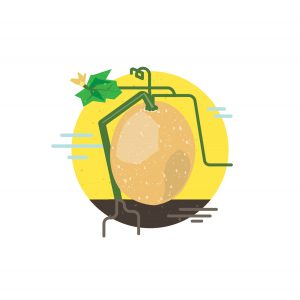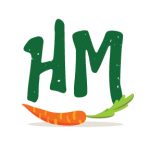LOCAL MELONS

You can include melons on the salad bar, in a fruit dish like Cantaloupe Salsa, as a breakfast fruit, in a fruit cup at snack time, or in a taste test. Included on this website are featured curriculum connections for melons, along with recipes for food service departments and for students and their families.
Agriculture Facts:
- Melon is a member of the Cucurbitaceae family. Its closest relatives are squashes and cucumbers.
- Best known varieties of melon are casaba, honeydew, Persian melon, and cantaloupe.
- Watermelon’s name came from the fact that about 92% of the melon is water.
- It takes cantaloupes 3-4 months to grow before they are mature enough to be picked. Melon does not ripen after it is picked, so once a cantaloupe is removed from the vine it will not sweeten any further.
- The Yubari King melons are the most expensive melons in the world. They are only grown in a small region of Japan. Due to this, they are very hard to find making them very expensive. The fruit is said to be the juiciest and sweetest melon in the world, and its orange flesh is coveted for its tenderness. Often given as gifts after being bought at auctions, a perfectly proportioned pair of these juicy melons can easily set you back well over $20,000.
Nutrition and Food Facts:
- The combination of its high water content and potassium levels make honeydew melon effective at maintaining healthy blood pressure levels. As honeydew contains both vitamin C and copper, they promote healthy skin by aiding collagen production and tissue repair.
- Cantaloupe is an excellent source of vitamin C, vitamin A, and beta-carotene. It is also a good source of potassium and contains significant amounts of B vitamins.
- Potassium, although a relatively small amount is in watermelon, helps balance fluids in your cells. (Low potassium levels sometimes cause muscle cramps.) Athletes will snack on watermelon before and after training.
- One cup of cubed honeydew provides 34 percent of the recommended daily intake of vitamin C. A serving of this fruit, 6 1/4 ounces, has 64 calories only with almost no fat and zero cholesterol.
- Cantaloupes are particularly beneficial to people with heart disease, as they have large of amounts of an anticoagulant known as adenosine.
History and Lore:
- Melons originated in Africa or in the hot valleys of Southwest Asia, especially Iran and India, from where they gradually began to appear in Europe toward the end of the Western Roman Empire.
- Melons are known to have been grown by the ancient Egyptians.
- “Honeydew” is in fact the American name for the White Antibes cultivar which has been grown for many years in southern France and Algeria. In China, honeydews are known as Bailan melons. They are famous locally near Lanzhou, the capital city of Gansu province in China’s northwest.
- The first documented use of the word “melon” was about 1395. John Ayto’s Dictionary of Word Origins suggests that the word is derived from Melos (the Greek Cyclades Islands, best known for the Venus de Milo).
- The seeds of cantaloupe were used in China to moderate fevers and the digestive system. Elsewhere, seeds were ground into a powder and used to treat tuberculosis.
Spread the word and build partnerships
Don’t be a solo act. Invite your community to the table!
Promote in-house:
- Announcements
- Newsletters
- Website
- Social media
- Events (health fairs, open houses, garden working events, back to school, holiday activities, parents night, sporting events)
- Meetings (PTO, wellness committee, board of directors, staff professional learning days)
- Food tastings during events
Promote in your community:
- Report on activities and share pictures with news sources
- Share with community partners for their websites, social media and newsletters
- Post fliers at public places (libraries, health centers, non-profit hospitals, garden groups, local farm hubs, farmers markets, health agencies)
- Ask students to create and publicize local food stories – include photos or create videos
Invite others onsite to get involved:
- Build impact by engaging culinary arts, Future Farmers of America, wellness, botany, ecocentric and garden programs
- Create relationships and engage non-profit hospitals, garden groups, local farm hubs, farmers markets, health agencies and advocates
- Find support in local culinary leaders and businesses
Curricular Connections and Activities
Early childcare/preschool:
- Melon Exploration from Growing Minds. Click here to view the PDF of the activity.
- Cantaloupe Corner from the USDA. Click here to view the PDF of the lessons.
K-12:
- Iowa Department of Public Health’s Pick a better snack activity for melons for early elementary age students. Click here for the K-1 activity, and here for 2-3 grade students.
- Harvest for Healthy Kids’ lesson plan for melons. Follow this link and download the PDF lesson plans for melons.
- Melons Lesson from U of I Extension in Champaign. Click here for the PDF.
Menu Logos – right click to save these images


Recipes
We have many recipes for you to look through in our Recipe Index! Here you can see take-home recipes for use in the community as well as more choices for your cafeteria. You will find hot and cold recipes for most foods. Be sure to use the provided icons on your menu!
Featured Food Service Recipe: Cantaloupe Salsa
Featured CACFP Recipe: Watermelon Salad
Featured Family Recipe: Watermelon Salsa Coming soon!
